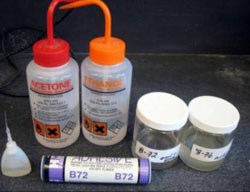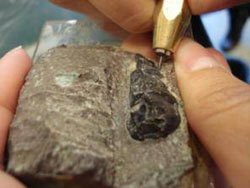Notoungulate
Finding
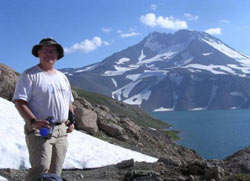
Dr. John Flynn, Frick Curator of Fossil Mammals, Professor, and Dean of the Richard Gilder Graduate School at the American Museum of Natural History, has been exploring for fossils in the Chilean Andes for over 20 years. The thousands of specimens that the paleontological teams have collected provide us with exciting new information on the evolution of South American mammals.
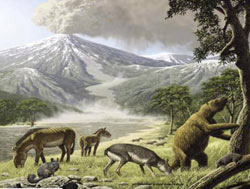
This illustration reconstructs the volcaniclastic activity that took place in this area beginning in the Eocene epoch about 56 million years ago, through the Miocene epoch which ended about 5 million years ago.. The animals depicted here represent some of the fauna that existed during this time period and that are now preserved in the fossil record. Over the millennia, this volcanic ash hardened into highly lithified rock, yielding a matrix harder than any other encountered at the AMNH.

Fossil specimens from the Chilean Andes are tremendously challenging to extract due to the exceptionally hard surrounding matrix. Field excavation often requires large gas-powered rock saws rather than chisels or pick-axes for extraction. It can take several hours to collect a single specimen under these conditions. To ensure that the entire specimen is collected in the field, a large block of matrix is cut, adding to the difficulty and the length of time of preparation. For more information on Field Collecting click here.
Extraction
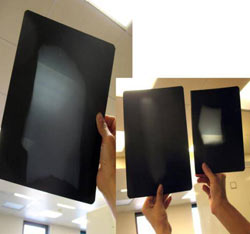
X-radiography images and CT scans were taken of a Chilean specimen to see if they would help determine the placement of the fossil within the matrix block. However, the density of this particular specimen and the surrounding rock were too similar to one another, making this kind of analysis of little use. As a result, Ana Balcarcel, the preparator working on this specimen, uses her knowledge of anatomy and prior experience to judge where to safely trim the block. For more information on non-invasive preparation techniques, such as X-rays and CT analyses, click here.
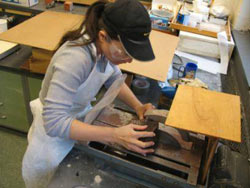
In the laboratory, Ana removes the bulk of the excess matrix using a diamond-bladed rock saw. Trimming of excess matrix in this fashion will reduce micro-preparation time by approximately two months.
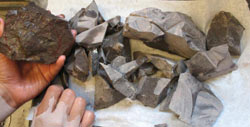
After cutting away the bulk of the rock surrounding the fossil (in this case almost eight pounds of excess matrix), Ana is finally left with a specimen that she can hold in one hand and start to prepare using mechanical tools. The fossil is located in the small area within the red circle.
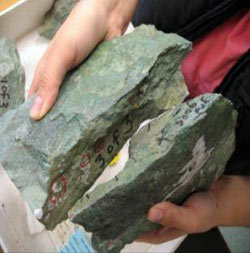 |
|
Some specimens must be excavated in numerous parts in the field. These must later be puzzled back together by the preparator in the lab. The pieces are tightly adhered together with strong adhesives before mechanical preparation begins.
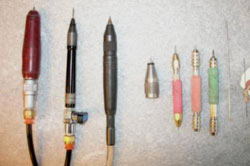 | 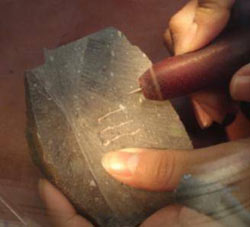 | |
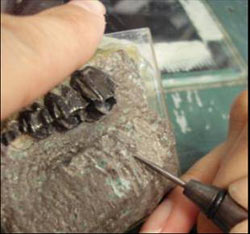 | 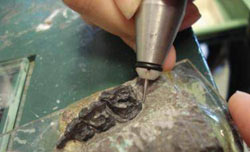 |
Micro-preparation utilizes a variety of tools. Mechanical tools used include the Chicago Pneumatic Drill, MicroJack 4, and the Aro Marxal with a “German tip”. Carbide needles in a pin vice are used for the finest detail work. Under a microscope, and at high magnification, Ana is better able to distinguish bone from matrix. Preparation time is determined by not only the size of the specimen, but also by the quality of preservation. Depending on these variables, preparation time can range from several weeks to many months. Click here for more information on preparation tools.
Studying
| 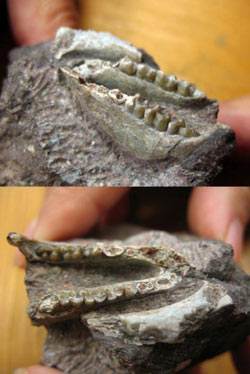 |
Upon completion of preparation, identification and study of the specimen can proceed.
The notoungulates illustrated here will then be integrated into the overall collection of Chilean specimens. All of this material will be catalogued, photographed, labeled, molded /cast and incorporated into a database.
The research conducted by Dr. John Flynn and his colleagues on this South American fauna has led to the discovery of new time windows and previously unknown taxa. These important new findings have been featured in many scientific publications. Click here for one example, in Scientific American Magazine.
